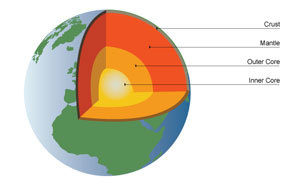9th Grade > Biology
NATURAL RESOURCES MCQs
Total Questions : 47
| Page 2 of 5 pages
Answer: Option C. -> Water cycle
:
C
The whole process in which water evaporates from the surface of seas and oceans and falls back on land as rain and later flows back into the sea via rivers is known as water-cycle. This is one of the ways in which the water present on earth is circulated all over the Earth.
:
C
The whole process in which water evaporates from the surface of seas and oceans and falls back on land as rain and later flows back into the sea via rivers is known as water-cycle. This is one of the ways in which the water present on earth is circulated all over the Earth.
Answer: Option B. -> Lightning
:
B
Nitrogen fixation is an essential biological process by which nitrogen in the atmosphere is converted into ammonia. Lightning is one of the physical processes that convert nitrogen into oxides of nitrogen. These oxides then dissolves in water to form nitrates and fall on land along with rain.
:
B
Nitrogen fixation is an essential biological process by which nitrogen in the atmosphere is converted into ammonia. Lightning is one of the physical processes that convert nitrogen into oxides of nitrogen. These oxides then dissolves in water to form nitrates and fall on land along with rain.
Answer: Option C. -> CFC
:
C
Chlorofluorocarbon (CFC) is an organic compound that contains only carbon, chlorine, and fluorine.This compound does not get degraded by any biological process. CFC reacts with ozone layer and it results in the depletion of ozone layer.
:
C
Chlorofluorocarbon (CFC) is an organic compound that contains only carbon, chlorine, and fluorine.This compound does not get degraded by any biological process. CFC reacts with ozone layer and it results in the depletion of ozone layer.
Answer: Option A. -> True
:
A
Gases and air molecules have a natural tendency to move from a region of high pressure to a region of low pressure and attain a uniform pressure throughout. When air above a region is heated, it starts rising up. As the air rises up, alow pressure region is created over that region.This will result in bulk movement of molecules of air from high pressure area to low pressure area which giverise to wind.
:
A
Gases and air molecules have a natural tendency to move from a region of high pressure to a region of low pressure and attain a uniform pressure throughout. When air above a region is heated, it starts rising up. As the air rises up, alow pressure region is created over that region.This will result in bulk movement of molecules of air from high pressure area to low pressure area which giverise to wind.
Answer: Option D. -> Nitrification
:
D
Nitrification is the biological oxidation of ammonia to nitrite followed by oxidation of nitrite to nitrate, performed by nitrogen fixingbacteria.It is a vital step in the nitrogen cycle and is essential for the survival of plant life.
:
D
Nitrification is the biological oxidation of ammonia to nitrite followed by oxidation of nitrite to nitrate, performed by nitrogen fixingbacteria.It is a vital step in the nitrogen cycle and is essential for the survival of plant life.
Answer: Option D. -> Oxygen
:
D
∙ Greenhouse gases are gases that have the ability to trap heat energy. Gases like carbon dioxide, methane, ozone, etc., are examples of greenhouse gases that lead to a rise in the Earth's temperature. Increased concentration of these gases are responsible for global warming.
∙ Oxygen, on the other hand, is not a greenhouse gas.
:
D
∙ Greenhouse gases are gases that have the ability to trap heat energy. Gases like carbon dioxide, methane, ozone, etc., are examples of greenhouse gases that lead to a rise in the Earth's temperature. Increased concentration of these gases are responsible for global warming.
∙ Oxygen, on the other hand, is not a greenhouse gas.
Answer: Option A. -> Evaporation, Condensation
:
A
When water bodies are heated during the daytime, a large amount of water evaporates and goes into the air. This is called evaporation. The hot air rises up carrying water vapour along with it. As the air rises, it expands and cools. This phenomenon is called condensation. The condensation of water vapour results in the formation of clouds. These clouds are carried away with the help of wind and when they become heavy they fall down in the form of rain.
:
A
When water bodies are heated during the daytime, a large amount of water evaporates and goes into the air. This is called evaporation. The hot air rises up carrying water vapour along with it. As the air rises, it expands and cools. This phenomenon is called condensation. The condensation of water vapour results in the formation of clouds. These clouds are carried away with the help of wind and when they become heavy they fall down in the form of rain.
Answer: Option C. ->
78% and 21% approx
:
C
:
C
Air is a mixture of many gases. It is primarily composed of approx 78% nitrogen and 21% oxygen with only small concentration of other gases such as carbon dioxide and argon.
Answer: Option A. ->
soil pollution
:
A
The addition or removal of constituents from soil, changing its natural composition is called soil pollution. There is a substantial decrease in soil fertility due to soil pollution. This is because of the addition of contaminants that alters the chemistry of the soil.
:
A
The addition or removal of constituents from soil, changing its natural composition is called soil pollution. There is a substantial decrease in soil fertility due to soil pollution. This is because of the addition of contaminants that alters the chemistry of the soil.

















